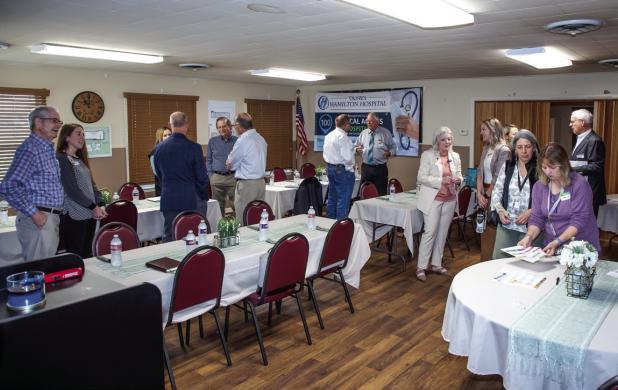
OHH, Tech confer on rural health issues
Olney’s new $33-million hospital project has captured attention from Texas Tech University Health Sciences Center, which sent a team to discuss potential collaborations in medical education and rural healthcare programs last week.
J. Michael Lewis, an Olney High School and Tech graduate who served as chairman of the Tech Board of Regents until 2022, brought the team from Tech’s Rural & Community Health to meet with administrators and board members from Olney Hamilton Hospital, as well as business, city and school district leaders, at OHH’s Education Center.
Mr. Lewis said he hoped to parlay his connections at Tech, with its $6-billion budget, 63,000 students and 20,000 employees, into some advantages for the new hospital and the rural medical community.
He was interested in “how do you build a sustainable model for the long term?”
The Tech team, consisting of Dr. Billy Phillips, executive vice president and director; Sarah Looten, managing director of staff relations; Dr. Ron Cook, Chief Health Officer; and Dr. LaMicha Hogan, Associate Dean and Department Chair for APRN Programs, School of Nursing, heard a presentation about the new hospital by Olney Hamilton Hospital Administrator Michael Huff.
Mr. Huff pointed out that OHH has operated for 115 years as an independent hospital and is one of the few rural Texas hospitals that still delivers babies. The hospital has expanded into pain management, wound care and nursing homes to turn a profit, and draws patients from the surrounding counties.
The Tech team queried the group, including City Councilman Harrison Wellman, OISD Board President Summer Branum, OEDC Board Member Kelly Mahler, OHH Foundation President and businessman Lewis Farmer and CEMCO President Carla Perry, about the community’s health needs and described programs that Tech could bring to the new hospital.
The group discussed establishing medical education classes at Olney High School and creating preceptorships for Texas Tech nursing and medical students at OHH as part of its T-CORE [Transforming Communities Through Outreach, Recruitment and Education] program.
Dr. Phillips noted that rural Texans “live in shortage and scarcity” sometimes hundreds of miles from the nearest medical facility or dentist - a situation that Tech is addressing with telehealth rigs that it runs out of EMS trucks, The Tech team also said it could implement a telemedicine program to evaluate mentally ill patients at OHH to fill a critical gap in mental health care in Young County.
The Tech team connected OHH administrators with contacts in its programs and made plans to reconnect in three to four months.
